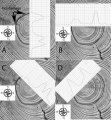Conspicuous Research of the Tunguska Explosion
X-ray scans over wood disks collected in the Tunguska region in 2008 partly unveiled the mystery of the Tunguska explosion. Several trees survived the event. While the trees contain a record of this event in the form of anomalous Ca concentration (and other elements), the size of the Ca anomaly also shows the direction towards the explosion epicenter. Figure: Four identical images of the larch anual rings, each showing the direction towards the TE epicenter (arrow in the compass rose). Graphical inset on top of each image shows the relative concentration of Ca across the wood section along a transect shown by the bottom edge of each inset. The x-axis distance scale on the Ca graphs has a 2-mm grid spacing, and the y-axis is the relative concentration of Ca. (A) North-south transect; black arrows show the extent of fire damage along the 1908 tree ring. (B) East-west transect; (C) Northwest-southeast transect; (D) Southwest-northeast transect.
Research results were published (Kletetschka et al. 2017: Survival Response of Larix Sibirica to the Tunguska Explosion) in the Tree-Ring Research journal.


